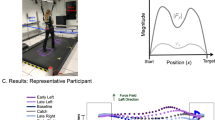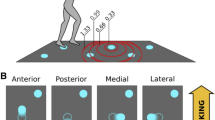Abstract
The constant bearing angle (CBA) strategy is a prospective strategy that permits the interception of moving objects. The purpose of the present study is to test this strategy. Participants were asked to walk through a virtual environment and to change, if necessary, their walking speed so as to intercept approaching targets. The targets followed either a rectilinear or a curvilinear trajectory and target size was manipulated both within trials (target size was gradually changed during the trial in order to bias expansion) and between trials (targets of different sizes were used). The curvature manipulation had a large effect on the kinematics of walking, which is in agreement with the CBA strategy. The target size manipulations also affected the kinematics of walking. Although these effects of target size are not predicted by the CBA strategy, quantitative comparisons of observed kinematics and the kinematics predicted by the CBA strategy showed good fits. Furthermore, predictions based on the CBA strategy were deemed superior to predictions based on a required velocity (V REQ) model. The role of target size and expansion in the prospective control of walking is discussed.







Similar content being viewed by others
Notes
One could also use the front or back edge of the target to compute the bearing angle. However, the alternative ways to compute the bearing angle would lead to similar results.
Partial η2 have the advantage of being independent of the other effects involved and is considered as an alternative computation of the absolute eta square (Tabachnick and Fidell 1989). However, please note that partial η2 values are not additive.
The nine time-intervals correspond to the first 4.5 seconds of each trial. The tenth time-interval of the 5-second trials was excluded because it showed large and apparently uninteresting variation.
References
Bastin J, Montagne G (2005) The perceptual support of goal-directed displacement is context-dependent. Neurosci Lett 376:121–126
Bastin J, Calvin S, Montagne G (2006a) Muscular proprioception contributes to the control of interceptive actions. J Exp Psychol Hum Percept Perform 32:964–972
Bastin J, Craig C, Montagne G (2006b) Prospective strategies underlie the control of interceptive actions. Hum Mov Sci 376:121–126
Bootsma RJ, van Wieringen PCW (1990) Timing an attacking forehand drive in table tennis. J Exp Psychol Hum Percept Perform 16:21–29
Bootsma RJ, Peper CE (1992) Predictive visual information sources for the regulation of action with special emphasis on catching and hitting. In: Proteau L, Elliott (eds) Vision and motor control. North-Holland, Amsterdam, pp 285–314
Bootsma RJ, Fayt V, Zaal FTJM, Laurent M (1997) On the information-based regulation of movement: what Wann (1996) may want to consider. J Exp Psych Hum Percept Perform 23:1282–1289
Caljouw SR, van der Kamp J, Savelsbergh GJP (2004) Catching optical information for the regulation of timing. Exp Brain Res 155:427–438
Chardenon A, Montagne G, Buekers MJ, Laurent M (2002) The visual control of ball interception during human locomotion. Neurosci Lett 334:13–16
Chardenon A, Montagne G, Laurent M, Bootsma RJ (2004) The perceptual control of goal-directed locomotion: a common control architecture for interception and navigation? Exp Brain Res 158:100–108
Chardenon A, Montagne G, Laurent M, Bootsma RJ (2005) A robust solution for dealing with environmental changes in intercepting moving balls. J Motor Behav 37:52–64
Craig CM, Berton E, Rao G, Fernandez L, Bootsma RJ (2006) Judging where a ball will go: the case of curved free-kicks in football. Naturwissenschaften 93:97–101
Ellard CG (2004) Visually guided locomotion in the gerbil: a comparison of open- and closed-loop control. Behav Brain Res 149:41–48
Fajen BR, Warren WH (2003) Behavioral dynamics of steering, obstacle avoidance, and route selection. J Exp Psychol Hum Percept Perform 29:343–362
Fajen BR, Warren WH (2004) Visual guidance of intercepting a moving target on foot. Perception 33:689–715
Ghose K, Horiuchi TK, Krishnaprasad PS, Moss CF (2006) Echolocating bats use a nearly time-optimal strategy to intercept prey. PLoS Biol 4:e108
Jacobs DM, Michaels CF (2006) Lateral interception I: operative optical variables, attunement, and calibration. J Exp Psychol Hum Percept Perform 32:443–458
Lanchester BS, Mark RF (1975) Pursuit and prediction in the tracking of moving food by a teleost fish (Acanthaluteres spilomelanurus). J Exp Biol 63:627–645
Land MF, Collett TS (1974) Chasing behaviour of houseflies (fannia canicularis). A description and analysis. J Comp Physiol 89:331–357
Lee DN (1976) A theory of visual control of braking based on information about time-to-collision. Perception 5:437–459
Lenoir M, Musch E, Janssens M, Thiery E, Uyttenhove J (1999) Intercepting moving objects during self-motion. J Motor Behav 31:55–67
Lenoir M, Musch E, Thiery E, Savelsbergh GJP (2002) Rate of change of angular bearing as the relevant property in a horizontal interception task during locomotion. J Motor Behav 34:385–401
Llewellyn KR (1971) The visual guidance of locomotion. J Exp Psychol 91:245–261
McLeod P, Reed N, Dienes Z (2006) The generalized optic acceleration cancellation theory of catching. J Exp Psychol Hum Percept Perform 32:139–148
Michaels CF, Oudejans RR (1992) The optics and actions of catching fly balls: zeroing out optical acceleration. Ecol Psyc 4:199–222
Michaels CF, Zeinstra EB, Oudejans RR (2001) Information and action in punching a falling ball. Q J Exp Psychol A 54:69–93
Michaels CF, Jacobs DM, Bongers RM (2006) Lateral interception II: predicting hand movements. J Exp Psychol Hum Percept Perform 32:459–472
Montagne G, Laurent M, Durey A, Bootsma R (1999) Movement reversals in ball catching. Exp Brain Res 129:87–92
Montagne G, Fraisse F, Ripoll H, Laurent M (2000) Perception-action coupling in interceptive tasks: First order time-to-contact as an input variable. Hum Mov Sci 19:59–72
Olberg RM, Worthington AH, Venator KR (2000) Prey pursuit and interception in dragonflies[A]. J Comp Physiol 186:155–162
Peper CE, Bootsma RJ, Mestre DR, Bakker FC (1994) Catching balls: how to get the hand to the right place at the right time. J Exp Psych Hum Percept Perform 20:591–612
Rossel S, Corlija J, Schuster S (2002) Predicting three-dimensional target motion: how archer fish determine where to catch their dislodged prey. J Exp Biol 205:3321–3326
de Rugy A, Montagne G, Buekers MJ, Laurent M (2000) The study of locomotor pointing in virtual reality: the validation of a test set-up. Behav Res Methods Instr Comp 32:215–220
de Rugy A, Montagne G, Buekers MJ, Laurent M (2001) Spatially constrained locomotion under informational conflict. Behav Brain Res 123:11–15
Rushton SK, Harris JM, Lloyd MR, Wann JP (1998) Guidance of locomotion on foot uses perceived target location rather than optic flow. Curr Biol 8:1191–1194
Savelsbergh GJP, Whiting HTA, Bootsma RJ (1991) Grasping Tau. J Exp Psychol Hum Percept Perform 17:315–322
Shaffer DM, Krauchunas SM, Eddy M, McBeath MK (2004) How dogs navigate to catch frisbees. Psychol Sci 15:437–441
Shankar S, Ellard C (2000) Visually guided locomotion and computation of time-to-collision in the mongolian gerbil (Meriones unguiculatus): the effects of frontal and visual cortical lesions. Behav Brain Res 108:21–37
Sun HJ, Carey DP, Goodale MA (1992) A mammalian model of optic-flow utilization in the control of locomotion. Exp Brain Res 91:171–175
Tabachnik BG, Fidell LS (1989) Using multivariate statistics. Harper Row, New York
Wann JP, Wilkie RM (2004) How do we control high speed steering? Optic flow and beyond. SA Beardsley, Kluwer Academic Publishers, Dordrecht
Warren WH, Kay BA, Zosh WD, Duchon AP, Sahuc S (2001) Optic flow is used to control human walking. Nature Neurosci 4:213–216
Wilkie RM, Wann JP (2005) The role of visual and nonvisual information in the control of locomotion. J Exp Psychol Hum Percept Perform 31:901–911
Author information
Authors and Affiliations
Corresponding author
Rights and permissions
About this article
Cite this article
Bastin, J., Jacobs, D.M., Morice, A.H.P. et al. Testing the role of expansion in the prospective control of locomotion. Exp Brain Res 191, 301–312 (2008). https://doi.org/10.1007/s00221-008-1522-6
Received:
Accepted:
Published:
Issue Date:
DOI: https://doi.org/10.1007/s00221-008-1522-6




